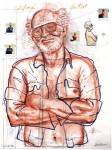
Robert Arneson
American, 1930-1992
Case of Bottles, 1963
stoneware and glass
10 1/2 x 22 x 15 in.
SBMA, Gift of Mr. and Mrs. Stanley Scheinbaum
1969.3

Robert Arneson, Self portrait, drawing, 1948, SBMA collection
"Bob's work was autobiography," said Seymour Howard, an art history professor emeritus who has written a book on autobiography in art. "That's how he talked, that's how he looked, that's how he was."
Arneson's widow, Sandra Shannonhouse, invites people viewing any Arneson work to look beyond what seems to be "edgy, naughty or funny."
"He used humor to draw the viewer into the piece, but there was usually much more going on," she says.
RESEARCH PAPER
Case of Bottles, 1963, is a case of glazed ceramic (stoneware) soda-type bottles, mounted on a metal pedestal. The case itself is mostly unglazed in a natural clay brown color. It is cracked in places with the word 'Pepis' scratched into the sides. The case holds four rows of six bottles each, all of them with an uneven aqua blue glaze that allows the rough texture of the clay to show through in places; there is one, however, which is a real glass 7Up bottle. The clay bottles are all of slightly irregular shape with all or a portion of the word 'Pepis" scratched in as if it were a label.
Robert Arneson was born about 1931 in a suburb of San Francisco and trained mostly in art education. He started teaching at Davis in 1962 after doing other teaching assignments. He is distinguished as an artist rather than as a craftsman because he works from ideas, not from form. Soda bottles were among his first ideas. From there he progressed to toilets, ceramic flowerpots with ceramic flowers, washstands, typewriters, teapots, dirty dishes, and his house on Alice Street. He has also done bricks and self-portraits which are among his most celebrated works.
Arneson...."utilizes Pop iconography and pun with a casual technique that displays its expressionist influences. The objects he reproduces in clay....exude the same temporal significance as Pop. But with Arneson's handling and choice of medium the pieces function as personal icons rather than the objectified cultural artifacts typical of Pop art." 1
"Arneson's overall accomplishment to date is somewhat uneven, especially his earlier single-shot whimsies closely related to and clearly dependent upon slightly earlier (1960-1965) Pop-Art ideas. His Soda-bottle pieces, his anthropomorphic telephones, his widely known typewriter with red-nailed fingers for keys, and his toaster containing a hand, however arresting they are, only point the way to his more recent work, which takes on an increasingly personal visionary, complex, sometimes even profound character. His probing of the various implications of puns, both visual and verbal, and, more broadly of metamorphosis, has brought Arneson into the larger area of metaphysical statement about the conditions and varieties of artistic processes and forms."2
1. "The Art of Peter Voulkos" by Hal Fisher, Art Forum, Vol.17 Nov. 1978, pp 41-47
2. "Robert Arneson's Feats of Clay" by Dennis Adrian, Art in America, Vol.62, Sept. 1974, pp 80-83
The bibliography also includes "The Ceramic Sculpture of Robert Arneson - Transforming Craft into Art" by Alfred Frankenstein,
Art News, Vol. 75, Jan. 1976, pp 48-50
Prepared for the Docent Council by Barbara Salibi, July 1980
Web-site Preparer: Josie Martin
SBMA CURATORIAL LABELS
Bottles is entirely handmade. Arneson captures the economical and efficient reductiveness of many massproduced objects. In the realm of visual art, reductiveness is often connoted by a lack of finish or refinement. Here, the artist has not smoothed edges or concealed the mark of his hand. A sketchier kind of modeling is apparent. The crate is constructed so that, over time, it succumbs to attrition. Inexpensive materials are used, some of them store-bought. Indeed, this rough style captures in conceit the immediacy and hasty creation of industrially produced objects. Moreover, it democratizes artistic production. While such an approach requires a steady hand, skill, and representational sense, anyone can be trained to take ubiquitous imagery and capture it through these means.
- WARES! Extraordinary Ceramics and the Ordinary Home, 2023
